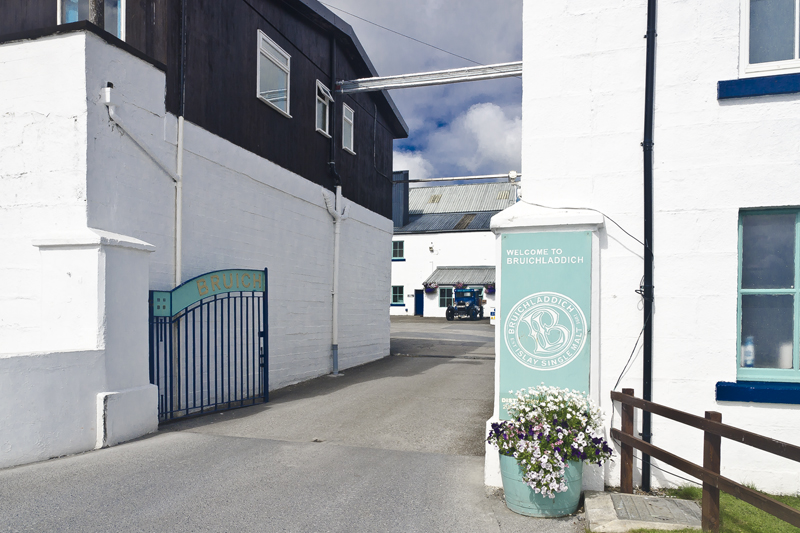Bruichladdich
2016-07-30
 Bruichladdich in a nutshell:
Bruichladdich in a nutshell:founded: 1881
owner: Bruichladdich Distillery Co
region: Islay
location: 55° 45’ 58” N 06° 21’ 42.5” W
status: active
capacity: 1,500,000 litres
washbacks: 6 Oregon pine
stills: 4 + 1 Lomond still
source of water: springs at Octomore farm
tours: yes
Bruichladdich
Located on the side of Loch Indaal from Bowmore on the island of Islay, Bruichladdich is a distillery that hardly anyone had heard about at the end of the 20th century, and the whisky produced there was a disappointment to many – how come, Islay whisky without the peat smoke? After the takeover by Murray McDavid in 2000, with Jim McEwan heading production, who abandoned Bowmore for Bruichladdich, the distillery underwent a true revolution, as a result of which the still and its products gained a really strong position on the whisky market. No wonder Rémy Cointreau were prepared to dish out 58 million pounds in 2012, in order to become the owner of that buoyant, successful Islay distillery.
The distillery dates back to 1881, when Barnett Harvey built the plant in the village of Bruichladdich on the northern coast of Loch Indaal. It was his three sons’ money that was used to fund the project. The money was left in Barnett’s brother’s will to the boys, so officially it is the brothers William, Robert and John Harvey who are remembered as the first owners of Bruichladdich. One of them, William, took over as the plant’s manager in 1889, and remained in that position until 1937. Besides numerous and relatively frequent changes in ownership, events in the history of Bruichladdich that are worth mentioning include the decommissioning of the maltings in 1961 and increasing the number of stills to four in 1975. In 1993 production stopped for a while, and in January 1995 the distillery ceased production for good.
Then comes the year 2000 and the transaction for 6.5 million pounds, as a result of which the distillery is sold by JBB Greater Europe to a consortium consisting of 25 partners headed by Mark Reynier of Murray McDavid. From now on, the distillery becomes the realm of Jim McEwan, and some of the warehouses are used for maturing casks of whisky from various distilleries that belong to Murray McDavid. Based on the old stocks purchased with the distillery, a new core range is composed, the labelling and bottle shapes change, and the new 10 year-old Bruichladdich takes the market by storm. Apart from that, new 15yo and 20yo expressions are launched. All of them a extremely well received by whisky enthusiasts.
Being an independent distillery, Bruichladdich unleashes he creative powers of Jim McEwan, a personage well-known in the world of whisky. Some of the whisky maturing in the warehouses is re-racked into various types of casks – wine, rum, sherry, madeira, port. There are experiments with unusually high levels of malt peating (Octomore whisky, peated at 80, 140, 167, 208 or even 258 ppm, depending on the batch). In early 2006 the news spread about experiments with quadruple distilled whisky from Bruichladdich, there is the Lomond still, the only one of its kind in the whisky industry, being installed there, and so on. All of that focuses a lot of attention on Bruichladdich, which develops at an unprecedented pace and soon becomes the largest single employer on the island. The plant gets its own bottling line, which makes it one of the very few stills capable of performing an entire production process – from grain to bottle – on one site.
In accordance with Jim McEwan’s philosophy, who says a whisky maker should be like a fashion designer – continually surprise their customers with all-new collections, the market is virtually flooded with countless new expressions of the whisky made here under three basic brands – traditionally unpeated Bruichladdich, peated Port Charlotte (40 ppm) and highly peated Octomore (80 ppm and more). However, as much as Bruichladdich could be bottled immediately after the distillery takeover, based on the old stocks, Port Charlotte and Octomore had to wait a bit for the respective spirits to mature. Port charlotte was launched in 2006 and Octomore in 2008. In 2014 an ultra-peated Octomore 06.3 was launched, with an unbelievable peating level of 258 ppm.
The Lomond still, that was mentioned before, is not used to make whisky, but a highly regarded The Botanist gin. The quadruple distilled Bruichladdich X4+3 Perilous Whisky was rather coldly received, but one must not forget that whisky distilled to such high levels can spend long decades maturing before the alcohol content drops below the legal level of 40% vol., which will make it the most expensive whisky in the world one day, according to Jim McEwan. Sounds logical.
Show more entries from
July 2016